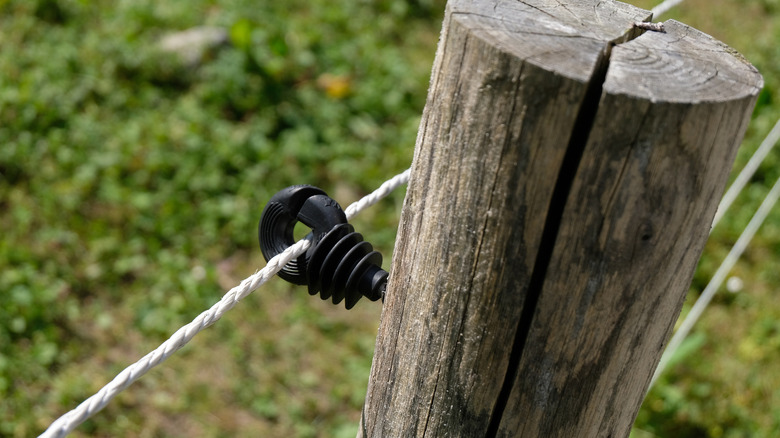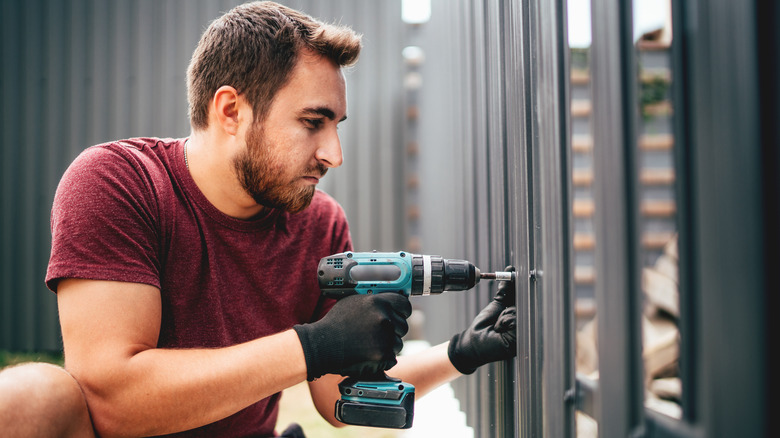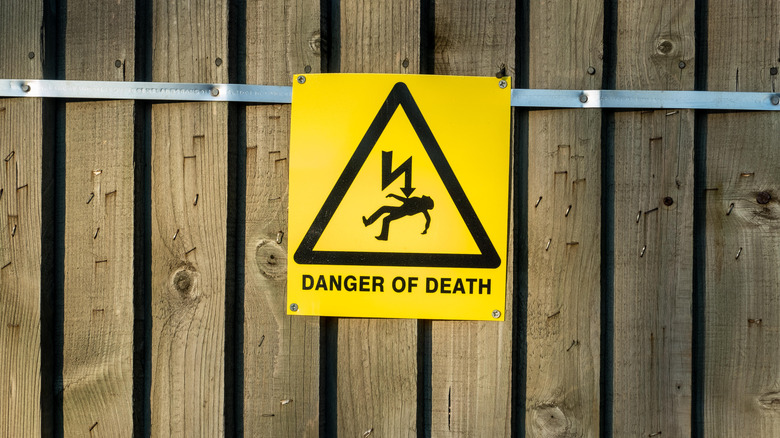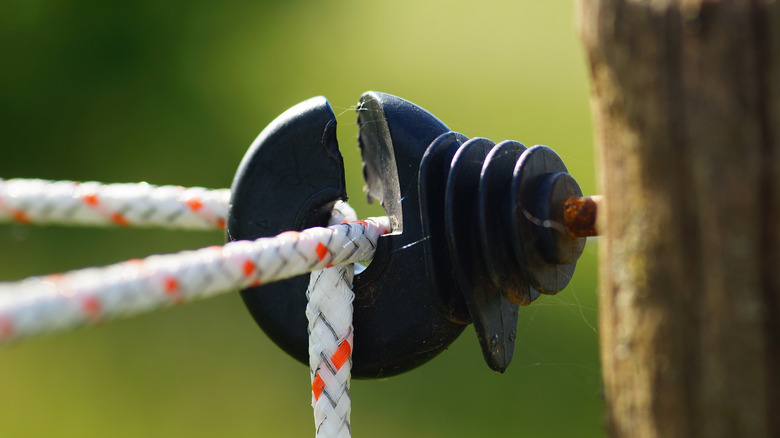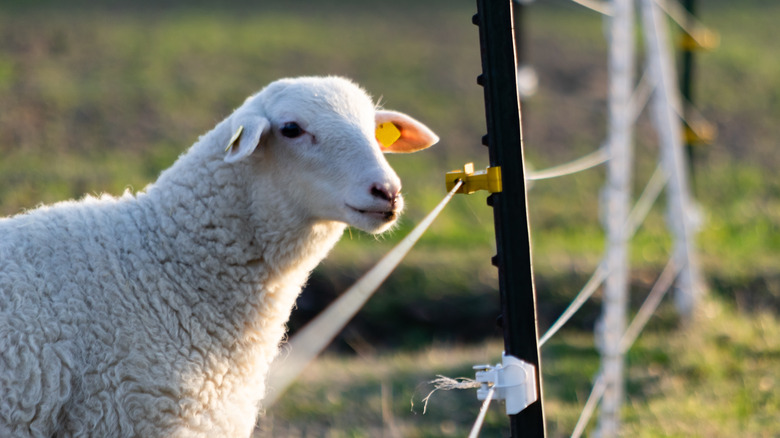How Much Does Fence Insulation Cost?
We may receive a commission on purchases made from links.
When it comes to installing an electric fence, there are several materials you will need. These materials include a grounding system, wire, posts, and most importantly the current, which produces an electric shock to those who touch or go near it. To keep the current flowing, however, insulators also need to be added to the electric fence. Fence insulators are used to hold the wire to the posts, allowing the electricity to flow through the wires of the fence without losing any of the current to the wooden or metal poles (per Red Hill General Store).
According to Crops Review, the most recommended insulator is the Dare Products Tube Post Insulators, which cost nearly $30 for a pack of ten (per Amazon). These insulators not only have the option of attaching either vertically or horizontally, but they can also attach to both square and round posts. For a less expensive option, Crops Review also recommends Electrobraid Line Post Insulators, which only cost a mere $12 for a pack of twenty (per Amazon). Although these insulators are only meant for wooden posts, they are known for being very durable; therefore, they can last through nearly any type of weather. If you want to learn more about fence insulators and the process of installing them on your electric fence, read on to explore the many options you have, as well as the various related costs.
Factors for cost
When it comes to adding or replacing the insulators on your electric fence, there are quite a few factors that can affect the overall price of your electric fence upgrade. Let's take a closer look below.
Location
Although you may not think that the location of your home has anything to do with the cost of your project, it can still play a significant role. Depending on where you live, the number of professionals available to assist you with your project may be scarce. If this is the case, it will likely cost you more to hire a qualified expert. The location of your home will also determine the shipping options and subsequent costs of ordering materials.
Along with the physical limitations of your location, your local government may also have special ordinances or regulations that could impact your project. Many municipalities require building permits for new structures, fencing included. Although the cost of each of these varies between local governments, Home Guide claims that you can expect to pay between $50 and $300 for rather small projects, like an electric fence.
Size and materials
Manitoba explains that each post of your fence needs at least one insulator. The type of insulator you need depends largely on the type of posts you have and their position. For example, a different insulator is used on the corner of the fence than on the straight portions. A fence with metal posts will also need a different insulator than one with wood or vinyl posts (per McGregor Electric's YouTube Channel). Regardless of type, most insulators cost around the same price depending on their quality. For high-quality insulators, Crops Review estimates that you can expect to pay around $30 for a pack of ten insulators.
For the electric fence itself, the size of the fence will also affect how much you will spend on materials, next to the quality of the materials. Angi states that on average, most materials range between the collective price of $400 and $1,900.
Geography
As common sense would indicate, the longer your fence, the more materials you will need to purchase. On average, most posts are spaced between 60 and 70 feet on flat land. On hillier terrain, however, the spacing between posts is shortened to between 30 and 40 feet. Of course, this is an approximation, and your actual spacing will be determined by the unique conditions of your property and what you are trying to achieve. Nevertheless, you can generally expect to need fewer materials and thus pay a lower cost if you are working with level ground versus more varied elevation.
Labor
Angi mentions that the cost of labor for an entire electric fence installation usually ranges between $600 and $1,800. The actual cost within this range depends on the length of the fence, the style, and the type of land on which the fence is installed. Steps to install a new fence involve digging each individual post into the ground, installing insulators, and properly running wire through them. Although you can save yourself a lot of work by hiring a professional, you'll save yourself money if you decide to go the DIY route instead, limiting your costs to materials and permits. If you're merely installing or replacing insulators on an existing fence, you should definitely opt to do it yourself, as it is a relatively quick and simple task that most homeowners can accomplish without the need for a professional, as McGregor Electric's YouTube Channel helpfully demonstrates.
Additional costs
In addition to the simple factors that lead into the cost of installing insulators and creating an electric fence, some additional expenses also need to be accounted for.
Existing structure
Depending on the structure that already exists for your electric fence, more than just the insulators may need to be installed. For example, if you have a regular fence you wish to convert into an electric fence, you must prepare to add a transmitter, receiver, and wires to run current through. Bankrate mentions that this system alone can cost between $900 and $1,300 to be properly installed.
If you are building the electric fence completely from scratch, you can expect to pay even more on top of whatever it costs to add the electrical elements. Home Serve Blog mentions that the cost of building a new fence is highly dependent on the type of material you use for it. On average, however, you can expect to pay between $15 and $60 per linear foot for a simple structure.
Cost of use
Pasture Pro explains that an electric fence is not an expensive element to run. In fact, it typically doesn't cost more than a dollar a month. To figure out exactly how much you will pay a month to run your electric fence, you must first examine how many watts of energy your fence uses per hour. Most electric fences range between 10 and 50 watts per hour, but specifics can be found in the manual that came with the system. If you can't find it there, you can try calling the manufacturer for that information. Once you know how many watts per hour your fence uses, you can multiply that number by the number of hours you used the fence in a month, then divide that total by 1000 to find the exact rate of consumption, which is measured in kilowatt-hours. If you know how much your utility company charges per kilowatt-hour, you can then determine the monthly cost.
Types of fence insulators
When it comes to fence insulators, there are two main materials that they can be made from: plastic and porcelain. The type you use should be highly dependent on the type of wire and the strength that wire has. According to Zareba, manufacturers create plastic insulators from either polyethylene, polycarbonate, or nylon because these strong materials are able to firmly hold a high voltage wire to a variety of different posts without energy escaping into the post. Porcelain insulators, on the other hand, are more heavy-duty versions of plastic insulators. Manufacturers usually create porcelain insulators from clay, quartz, or feldspar, which are easier to physically break, but can last nearly a lifetime when installed onto your electric fence properly. Now we can examine some of the different types of insulators that are available for your specific fence and the positions they must hold on to that fence.
Corner post insulators
Corner post insulators are insulators that are specifically used for the corner posts of your fence. Zareba states that, unlike regular insulators, corner post insulators need to be able to withstand more pressure than any other part of your fence. Because the corner of your fence acts as an anchor, tension builds up from the wire pulling from each side, which needs to be held by a stronger insulator. Depending on the quality of the corner post insulator you decide to purchase, it can either be more expensive or the same price as a regular insulator.
Tube clamp insulators
Unlike other types of insulators that need to be drilled into the surface of the post to function properly, Home Depot states that a tube clamp insulator simply mounts a round post by wrapping around it vertically or horizontally without the need to drill any holes. This makes them also great for protecting important above-ground pipes that carry things like water and oil. Similar to other insulators, however, tube clamp insulators are still durable and very easy to use.
Chain link insulators
Chain link insulators are insulators specifically designed for chain link fences, which would otherwise be difficult to upgrade to an electric fence. Kencove Farm Fence Supplies mentions that chain link insulators easily attached to the links of a chain link fence and hold the electrified wire at a safe 4 ½ inches away from the surface of the fence. Aside from just chain link fences, chain link insulators also work great on both T-posts and U-posts.
Maintaining your electric fence
Once you install an electric fence on or around your property, it is subjected to a variety of climate and weather conditions. Exposure to these conditions can affect the functionality or even cause damage to your electric fence over time. There are, however, several ways you can maintain your electric fence as the seasons go by, helping it both function properly to avoid unwanted problems and damages.
Winter maintenance
Out of all four seasons, the winter season is known to affect your electric fence the most, especially in places that receive an abundance of snow. Zareba states that your electric fence can quickly loose its effectiveness due to the colder temperatures, which slow the flow of your electrical current. Snow can also end up insulating the current, making it ineffective against unwanted guests attempting to pass through. As snow piles onto the wires and posts of your electric fence, the weight can also eventually cause physical damage. Although many of these conditions are unavoidable, you can at least prevent damage by clearing snow off your fence after a heavy downfall.
Spring maintenance
Zareba points out that spring is the best time to fix any damages that may have occurred during the winter season. In the beautiful spring weather, take the time to walk the perimeter of your fence and thoroughly check for any damage. Some issues you should keep an eye out for are frayed broken wires, loose or dislodged insulators, or debris that has fallen onto your fence.
Summer maintenance
As spring turns into summer, plants begin to reappear, which can cause new problems for your electric fence. In the warm summer air, plants may grow tall enough to touch your electric fence. Although this won't cause any damage to the fence per se, it will reduce the effectiveness of the electric current. Instead of being focused on the path of the wires, the current is diverted to the adjacent plants, diluting the power. To avoid this issue, trim back taller plants as they spring up around your fence.
Fall maintenance
Fall is all about preparing for winter. Because winter carries the most potential of causing harm to your electric fence, the precautions you take in the fall are crucial to your fence's winter survival. One thing Zareba suggests is loosening the tension between your wires, especially if you are in an area that receives a lot of snow. In doing this, you can prevent the wires from being strained to the point of breaking if snow accumulates and weighs them down.
Regular inspections
Along with the maintenance you conduct each season, Zareba also recommends putting time aside every other month or so to thoroughly inspect all the parts of your electric fence to ensure they are not damaged and are functioning properly. During this process, you should check that your posts are sturdy and don't need replacing, gates open and close properly, insulators are still attached to posts, wires are strung firmly instead of hanging loose, and the voltage of the fence is at a safe and steady level. Doing these things will allow you to catch small problems before they turn into big issues, and give you confidence and peace of mind that your electric fence is doing its job.
Benefits of having an electric fence
Fences are placed around properties for a variety of reasons, whether that be for protection or privacy. As popular as regular fences seem to be, there are a few misconceptions when it comes to electric fences. These tend to revolve around claims that electric fences are inhumane to livestock or wildlife that can come into contact with them. Warefencing, however, clarifies that electric fences are not inhumane because they are specifically designed so that the currents sent through the wires are only amplified to cause discomfort, but no physical harm or damage to any animals that may brush against them. In addition, electric fences also come with plenty of benefits for you, your property, and the animals themselves.
Safety
As mentioned before, electric fences are made to cause discomfort rather than physical harm or damage. Especially compared to other types of fences or barriers you could place around your property, an electric fence is by far the safest route to go. For example, barbed wire fences are designed to cause physical damage to intruders, and with more tightly woven wire fences, you run the risk of finding an animal entangled and trapped in your fencing, which can hurt both parties. Electric fences merely give off a mild shock to warn intruders to stay away, with no lasting harm or ill effects (per Zareba).
Flexibility
Zareba points out that electric fences provide a great deal of flexibility in terms of both size and style. Nearly any type of fence can be upgraded to an electric fence, whether it be a permanent, semi-permanent, or portable fence for a variety of different terrains and weather conditions.
Ease of installation
Another great thing about electric fences is that they are not difficult to install. When it comes to electricity, you may feel inclined to stay away from the installation process, but most people rarely need the help of a professional when installing an electric fence. Depending on the length of the fence, the process can become long and tedious, but it is not difficult.
Affordability
Surprisingly, Zareba also claims that electric fences are also not expensive to install or run around your property. Especially when compared to the more harmful fences, like barbed wire and woven fences, electric fences tend to be the cheapest.
Effectiveness
Most importantly, along with their affordability, electric fences also tend to be very effective in protecting your property. Whether it's used to keep livestock in or predators out, an electric fence is strong enough to both physically hold their ground and ward off unwanted passersby.
